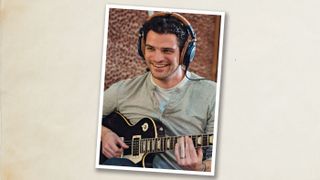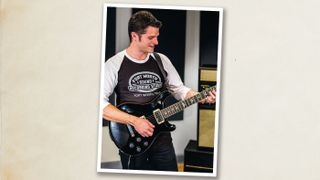The Snarky Puppy man talks about how his job remains the same irrespective of genre and muses on the origins of inspiration in everything he does...
It began with a buzz among the muso community. The word on the street was that Snarky Puppy were the band to seek out and, as a result, became quickly elevated to the same sort of status as groups such as Tower Of Power - dynamic and groove-laden, the individual members fusing together and making the most demanding music seem like a gentle afternoon’s stroll in the park.
There’s been a roll call of great musicians pass through the Puppies during their 13- year existence, with Mark Lettieri currently holding down guitar duties. Renowned for an ability to turn his hand to virtually any style, we were fascinated to explore his full range of endeavours, from the band, to session work and his own solo projects.
1. When the pupil is ready…
“I started as an 11 year old in the California Bay area. My dad plays a little guitar, not a professional musician, more of a hobbyist, but there’s always been a guitar in the house and so I grew up just smashing around on one. I took some lessons as a kid and as a teenager with some great teachers and just gravitated towards everything that was cool about guitar.
“I started out being interested in grunge rock - I remember hearing Soundgarden and all those bands on the radio and playing along. Then a friend introduced me to Jimi Hendrix and that was ‘the lightbulb’ for me. I realised all these things you could actually do with a guitar.”
2. …draw all your influences together
“I got into players like Satriani, Eddie Van Halen, Jeff Beck and Eric Johnson - that’s always stuck with me because these guys were making really cool instrumental music. That’s been something that I’ve tried to do for a little while now and, of course, that broke off into more jazz-orientated stuff like John Scofield and Charlie Hunter.
“I got really heavily into Prince - still am - and studied a lot of gospel guitar in the last couple of years. It’s a combination of finding my own sound through these influences, but using them to be versatile from a practical standpoint as a player.”
3. Keep your options wide open
My job is the same no matter what the genre is. I’m called upon to apply guitar in a unique manner that serves the song or the composition
“I did a guest guitar feature on a record that Snarky Puppy did called Bring Us The Bright, and shortly after, there was a weekend of shows that the other two guitar players in the band, Bob Lanzetti and Chris McQueen, weren’t available for so Michael [League] called me and said, ‘Can you learn 13 songs in two days?’ I lied and said, ‘Yes!’
“I was already familiar with the music because I’d seen the band, and so I did a handful of shows with them - I guess that was my audition - and just got onto the roster from then. I still don’t feel worthy of my position in the band. It’s obviously a pretty daunting gig - a source of great joy and great stress.”
4. Strive to keep consistent
“My job is the same no matter what the genre is. I’m called upon to apply guitar in a unique manner that serves the song or the composition. Working with David Crosby, on the two songs I played with him, I played baritone guitar primarily as almost like a textural type of part.
“The song with 50 Cent, I actually didn’t even meet him, he wasn’t even there. I worked with the producer, who was a Dallas guy, and we went to his studio and it was me and him. He had a track lined up and we just started throwing guitar parts at it, figuring out what stuck, essentially. Basically, in the hip-hop world, that’s kinda how it works!”
5. Clarity begins at home
“Some of these sessions, I do out of my home studio. That’s an interesting point to make about the way that the music business is now. I did Keyshia Cole’s record from my house and it was actually the same producer that did the 50 Cent stuff - he emailed me a track and I don’t know that there were even vocals on it.
“It was just drums, bass, keyboards and maybe some background vocals and synthesizer effects. So I was able to produce myself, in a sense. I’ll usually send them what I call a ‘guitar choir’ - lots of parts that are complementary, but not all necessarily needed for the final song. Then the producer can pick and choose what they like out of it.”

6. It’s not about the pyrotechnics
“I produce and arrange my own records, so I’m thinking like a producer and an arranger. It’s not so much about the guitar fireworks as it is just making a great song and a great production. For me, the song and the arrangement are always first and I will apply the guitar fantastic-ness as it is needed.
“On guitar records, that really hit me as a listener, especially Jeff Beck’s stuff in the 70s - there’s obviously some maniacal guitar playing, but that’s not what I remember about Wired or Blow By Blow. I remember that the grooves are really strong, the tones are great and the melodies are really cool. So that’s what I look for when I go and do my own records.”
7. Inspiration can come from anywhere
“Usually, at some point in the year, I will have amassed a library of iPhone recordings of riffs or melodies, or maybe full-fledged demos, that I’ve put together at my studio. I can be inspired by just about anything.
“Some of the songs were inspired by just the title, before I even have the music, because I think that way; I’m inspired by words. It’s simple stuff - things I see in my everyday life, experiences I have.
“Maybe a technique or sound I had to develop for a session might inspire something that I would end up going home and writing. So it can come from all sorts of places, which is good - I try to remain open in that respect.”
8. Assemble all the right tools
I’m definitely a fan of J Rockett Audio Designs for overdrives. And there’s always an MXR or TC Electronic thing on my ’board
“I usually use a Don Grosh NOS Retro as my main guitar. It’s a Strat-style, but he’s done some slightly unique electronics - I can get a Telecaster sound out of it if I want. It’s a heck of a guitar. That goes with me most of the time.
“I have two Teles that I enjoy. I use a Collings I-35 hollowbody, which is great, and I’ve been doing a lot with my Danelectro baritone, at least on social media, doing these miniature funk vignettes. Lately, this really fantastic PRS 594 McCarty has replaced my Les Paul!”
9. Boutique isn’t always the best
“I have a couple of really cool boutique amps: I use a Pure Sixty-Four, a company out of New York, and Naylor amps. I’ve got a great little PRS grab ’n’ go combo called the Sonzera, and I use a lot of Supro amps as well.
“They’ve been really good with Snarky Puppy, they’re always sending us out with amps on the road and I tend to favour their Royal Reverb combo - it takes pedals really well. That’s what I look for in an amp. I don’t really do the amp overdrive thing - at least, not live - so I need something that’s going to be big and fat and clean with a lot of headroom that will take a pedal.”
10. Pedal your wares with care
“I’m definitely a fan of J Rockett Audio Designs for overdrives - I’ve been using them almost exclusively for several years. And there’s always an MXR or TC Electronic thing on my ’board. I mix and match their reverbs and delays and phasers and octave pedals.
“I guess probably they’re competitors in the pedal genre, but their stuff sounds so different that I can use them both and each have their own special place. That would make up most of my ’board, then I use those Line 6 M Series pedals fairly often. They have these great synthesizer guitar patches on those things that can really get you in a lot of trouble!”



